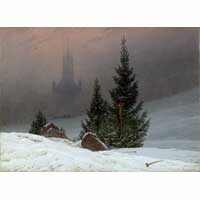In anticipation of the New Year, this week’s work of art is Winter Landscape by the German Romantic painter Caspar David Friedrich: a picture intended to prompt sombre reflections on the crossing of thresholds and the long journey of life. It was painted in 1811.
“Despite what many artists believe, art is not and should not be merely a skill,” Friedrich declared. “It should actually be completely and utterly the language of our feelings, our frame of mind; indeed, even of our devotion and our prayers.” Winter Landscape was an early attempt to put such ideas into practice. A small work, but conceived with great ambition, it is one of the first examples of a new genre pioneered by Friedrich: the devotional painting in which primacy has been given to the depiction of a grand and awe-inspiring landscape, as if to suggest that it is above all to nature that we must turn to find the grace of God.
On a bleak and snow-filled plain, a crippled traveller has cast aside his crutches to rest before a wayside crucifix set up in a stand of fir trees. Leaning against a boulder – the rock of faith – he clasps his hands together in prayer and gazes up worshipfully at the carved figure of Christ on the cross. In the misty distance a great Gothic cathedral looms in silhouette, as ethereal as a vision. Its form rhymes with that of the carefully composed arrangement of firs, reinforcing the point that nature is God’s cathedral too.
In Friedrich’s work, religious feeling and the experience of landscape seem so inextricably interwoven that it is difficult to say whether the church has been designed to make the trees seem charged with holiness, or whether it is the other way round. This ambiguity appears...

ITP 89: Winter Landscape by Caspar David Friedrich
31-12-2001

